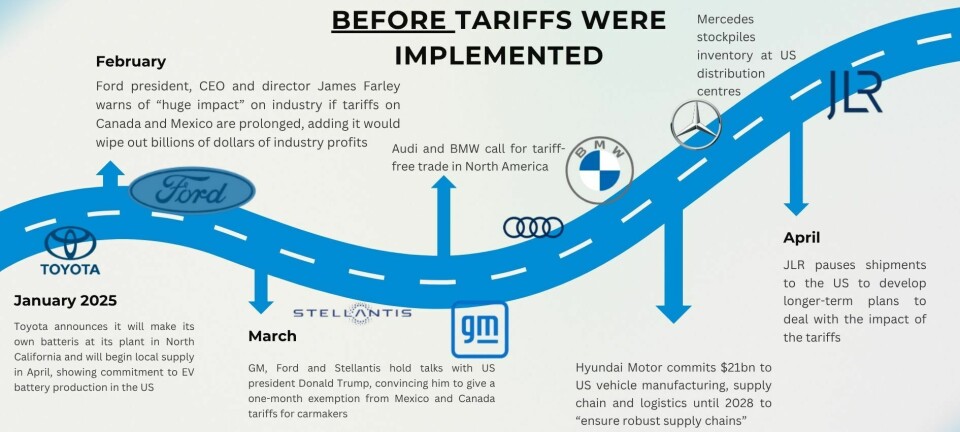Tariff timeline: US collects $26 billion from automotive tariffs in 2025
Will 2025 be remembered as the year tariffs reshaped global trade? Automotive Logistics tracks the escalation month by month in this timeline overview, with the latest developments following the release of tariff statistics from US Customs and Border Protection.
By the start of 2025, it was clear that tariffs would form the backbone of
Donald Trump’s second-term agenda. Since then, there have been so many delays, tariff changes and trade wars and deals that it's been hard to keep track - so we've done it for you.
The timeline below charts the most significant tariff decisions of 2025 – month by month – as they reshaped the rules of global automotive commerce.
December 2025 tariff updates for automotive logistics & supply chain
How much did the US make from tariffs this year?
US claims automotive tariffs bring in more than $26 billion in the six months from April to October 2025:
- The US Customs and Border Protection (CBP) collected $216.7 billion in revenue from all imported goods in 2025
- Of this, imports of finished vehicles accounted for $18.33 billion, while imports of automotive parts accounted for $7.61 billion
- Other section 232 tariffs brought in $4.83 billion from steel imports, $2.96 billion from aluminium imports and $514m from copper imports
UK and South Korea sign trade agreement:
- Deal allows greater export of finished vehicles from UK, lowering the number of parts in a vehicle that must be British or from the EU to quality for zero tariffs from January
- Agreement sees rules of origin requirements drop from 55% to 25%
November 2025
Imports to Port of Los Angeles down:
- Imports to the US' busiest seaport decrease 11.5% volume year-on-year in November
- Imports to all US ports fall 7.8% year-on-year in November
Switzerland and the US reach a trade deal on tariffs:
- The US agrees to cap tariffs on Swiss goods at 15%, down from the 30–39% range that was imposed earlier in 2025
- While unlikely to majorly affect finished vehicle exports, since the country doesn't have any large production base, it's likely to affect the export of automotive parts to the US. According to Swiss trade data, exports of automotive parts from Switzerland to the US in 2023 amounted to about $7.78m
October 2025
US increases Canada tariff:
- Tariff increase of 10% announced on imports from Canada
Tariffs impact VW Group's bottom line:
- VW Group reported a 33% decline in operating result for H1 2025 when compared with H1 2024, claiming this was primarily due to high costs from increased US import tariffs; it calculated the impact of these tariffs at €1.3 billion ($1.5 billion)
US and China progress:
- US president Donald Trump meets with Chinese president Xi Jinping to reduce tariffs on China, and in exchange China agrees to continue rare earth exports from the country.
China reversed export restrictions on semiconductors after Trump-Xi meeting, marking progress in the Nexperia chip crisis
US technology prosperity deals in Asia:
- During Trump's trip to Asia, the US signed technology prosperity deals with both Japan and South Korea; the deals formalise plans for future collaboration in areas such as artificial intelligence, 6G technologies and fusion energy.
Expanded Section 232 tariffs on medium and heavy-duty vehicles and parts:
- Effective from 1 November 2025, the US government has imposed 25% tariffs on imported medium and heavy-duty vehicles (Classes 3-8) and 25% on many of their parts.
- For vehicles and parts that are compliant under the USMCA rules, the tariff applies only to the non-US content in some cases.
Stellantis looks set to localise US production:
- Stellantis invests $13 billion in US manufacturing, while tariff negotiations continue.
Carmakers spread the cost of tariffs but prices set to rise:
- At ALSC Global, analysts say that costs are being absorbed by OEMs through a range of mitigating strategies as they wait and see how the tariff debacle will play out.
Port congestion, competition pressures loom as Mexico set to increase tariffs on Chinese vehicle imports:
- Automakers in Asia and logistics firms around the world are grappling with uncertainty as they begin to prepare for the impact of an increase in Mexico’s tariff on Chinese vehicle imports from 20% to 50%.
Steel, aluminium and broader material tariffs remain elevated:
- The US continues to impose 50% tariffs on many steel and aluminium imports — for example, parts used in automotive body-shop (e.g., chassis components, axles, mounts) now face the 50% rate instead of 25–27.5%.
While vehicle/parts tariff relief for EU origin is conditioned on EU legislation, full implementation timing remains unclear.
- With Japan, a deal was reached whereby Japanese automotive exports to the US face a 15% tariff (reduced from an earlier contemplated higher level). Steel and aluminium tariffs remain separate.
September 2025
OEMs react further to deepening impacts of tariffs:
- Nissan announced that it will drop the 2026 Ariya electric SUV from its US. lineup. One of the reasons cited is the 15% tariff imposed on Japanese-built EVs under the US–Japan trade framework.
- Hyundai is expanding its US output, boosting capacity in Georgia, and has adjusted its operating profit margin targets downward to account for tariff pressures. The company is also accelerating its plans for its hybrid and EV portfolio in North America.
- Volvo Cars is accelerating US-based production, committing to produce a new hybrid model in South Carolina by 2030. This is clearly a strategy to reduce exposure to import tariffs.
Continued uncertainty and what’s still in flux:
-
The Supreme Court decision is now the center of attention. Because the appellate ruling invalidating much of the reciprocal tariff scheme is stayed through mid-October pending appeal, businesses are in a holding pattern. OEMs and suppliers must plan under tariffs that may be reversed (or significantly modified) if the court rules against them.
For parts of the tariff regime not covered by the August ruling, or example, Section 232 tariffs (steel, aluminium) and other trade-remedy or security-based tariffs, there has so far been no court decision invalidating them. They continue to impose elevated costs and uncertainty for automotive OEMs and suppliers.
Countries that negotiated deals (Japan, EU) or that had exemptions and special arrangements now face questions about how stable those deals will be if the legal basis for many tariffs is overturned. Also, automotive companies must assess whether to push for refunds or duty protests for tariffs paid, depending on legal outcome.
Product lineups are being adjusted. EV models or lower-volume vehicles especially are at risk if tariff costs can’t be absorbed. As with Nissan/Ariya, automakers may choose to limit or delay models, shift imports, or reallocate resources to models built domestically or under favourable trade agreements.
Customs, classification, and parts supply chain complexity increase. When parts or assemblies cross borders or involve imported content, correctly classifying them under HTS codes, knowing which piece of the tariff regime applies (IEEPA/Section 232/trade-deal/exemption) can make big cost differences. Demand for trade compliance expertise is up.
August 2025
US extends steel and aluminium tariffs:
- The US extends the scope of 50% tariffs on steel and aluminium on August 19, adding 400 additional items to the levy. The expanded scope includes car parts such as chassis components, axles, steel wiring, brackets and mounts, and parts of heavy vehicles.
- This means these products, which are not listed under the car parts tariff of 25% to 27.5%, will be taxed at a higher rate of 50%. OEMs will need to review codes carefully to determine which parts will be tariffed at which rate.
- The new scope also targets product codes for derivatives and products made from the materials, including the likes of paints and sprays, which are often used in the automotive supply chain, and stamped components.
- Truck trailers are also added to the list, further complicating automotive logistics.
US-EU trade deal:
- The EU paused planned retaliatory tariffs on US exports (including automobiles), covering €93 billion ($101 billion) in goods. The suspension is expected to last six months, pending the outcome of ongoing trade talks.
- The pause is linked to the US-EU framework deal from late July, which aims to de-escalate trade tensions and foster cooperation. Under the deal, the US agreed to cap vehicle and parts tariffs at 15%, down from around 27.5%, while the EU committed to boosting investment in key US sectors such as clean energy, semiconductors and automotive manufacturing.
- The EU tabled legislation to cut tariffs on US products, aiming to unlock the US commitment to lower auto tariffs from 27.5% to 15%, retroactive to August 1.
- German car lobby groups (VDA, VDIK) publicly urged Washington to move “swiftly” in reducing tariffs on EU car imports in response.
US goods imports see steep drop:
- The US Commerce Department indicates the US trade deficit in goods fell roughly 16%, declining from $71.7 billion in May to $60.2 billion in June.
- A significant contributor to the decline was a drop in automotive imports, with vehicles, parts and engines falling by $1.3 billion.
OEM fallout continues:
- JLR profits halve due to tariff impact.
GM plans to import EV batteries from Chinese battery producer CATL, despite the tariff of 30% on imports to the US from China.
Toyota plans manufacturing plant in Japan, despite US tariff impact. The OEM expects a $9.5bn hit from the US tariffs.
- Mazda projects a $319 million operating loss for fiscal year 2026 due to US tariffs – assumed at 15% on Japanese imports and 25% on vehicles exported from Mexico.
Ford, GM and Stellantis expect to absorb billions in tariff-related losses this year.
Truck makers (Daimler Truck, Traton, Volvo) leverage production in Mexico to qualify under USMCA rules and avoid the highest duties.
'Reciprocal' tariff updates:
- Initial 90-day pause on reciprocal tariffs expired on August 1 (from an earlier July 9 expiry).
- New tariffs across many countries set to take effect August 7, following a July 31 executive order establishing country-specific 'reciprocal' rates – including a 10% baseline tariff for most nations, higher rates of 15% for trade-deficit countries, and tariffs ranging from 25% to 41% for countries like India, Canada, Brazil, Switzerland and Iraq. The White House has stated these rates are "pretty much set," with limited room for negotiation, and special provisions include a 40% penalty on transshipped goods and exemptions for imports already on route, provided they arrive before October 5.
- US Court of Appeals rules 'reciprocal' tariffs illegal, stating that the actions taken by the president to implement the duties were “unbounded in scope, amount and duration”. Tariffs will remain in place until October 14, giving the US administration time to appeal to the Supreme Court before the ruling takes effect. The legal case has been fast-tracked: the Supreme Court has agreed to hear the appeal, with arguments scheduled for early November 2025.
US-China truce:
- On August 11, the US and China extended their tariff truce until November 10, holding tariff caps at 30% on Chinese imports and 10% on US imports.
US doubles tariffs on India:
- Tariffs on goods imported from India rise from 25% to 50%.
- As a result, India plans to diversity its export markets, focusing on regions like the UK, Australia, UAE, South-East Asia and the EU.
- New rate does not apply to vehicle imports or designated automotive parts imports, but could still effect other components used in the automotive supply chain, such as castings, forgings, tyres, wire harnesses and metal parts, of which India is a major exporter to the US.
Progress on deal with South Korea:
- On July 31, Trump announced an agreement reducing auto tariffs on South Korean goods from the threatened 25% to 15%. The deal includes $350 billion investment in US projects such as shipbuilding, chips and batteries.
- On August 1, the Asian nation's trade minister said there is no written agreement yet on a trade deal between South Korea and the US.
July 2025
OEM fallout:
- Stellantis reports €2.3 billion ($2.3 billion) in H1 tariff-related costs; industry-wide margin erosion includes VW Group and Porsche.
- GM announces its Q2 core profit fell 21%, with a $1.1 billion tariff impact, and warns of a full-year tariff cost of $4-5 billion.
Trade talks accelerate:
- The deadline for implementation of 'reciprocal' tariffs pushed from July 9 to August 1.
- Final push for deals with Canada, Mexico, India, Brazil and others before August 1.
- Deals are made with the likes of Japan and Vietnam. On July 22-23, the US and Japan finalised a bilateral trade agreement that reduces reciprocal tariffs on Japanese vehicles and auto parts from 27.5% (including a 2.5% baseline and an additional 25% auto-specific levy) to a flat 15%. Vietnam, meanwhile, agreed to a 20% tariff on its exports to the US, avoiding the 46% “reciprocal” duty threatened by president Trump on “Liberation Day.”
- US-EU deal ratified, reducing auto and part import duties to 15%.
- Korea begins final negotiations, setting the stage for its August agreement.
The US Senate passes the 'One Big Beautiful Bill':
- Ends EV tax credits early and cuts off remain IRA funding.
- Has implications for battery and EV component projects that are still in development.
- United Auto Workers (UAW) warn of 20,000 potential job losses from the EV slowdown and plant mothballing tied to IRA cancellation.
June 2025
Upcoming deadline for more tariffs:
- A key deadline of July 9 will see further tariffs potentially enacted, unless countries engage in talks with the US "in good faith".
- Failure to do so may trigger additional reciprocal tariffs, especially on high-deficit trade partners.
Steel and aluminium tariffs raised:
- As of June 4, the US doubles steel and aluminium tariffs to 50% for all imports, aside from those from the UK, which remains at 25%.
- This impacts both finished auto parts and raw materials, increasing cost pressures on domestic OEMs and tier one-three suppliers.
- Automotive sectors reliant on imported flat-rolled steel, castings or extrusions are particularly affected (such as: EV platforms, body-in-white structures, chassis, and control arms).
Rare earth and US-China trade framework:
- China and the US make some progress, with Trump claiming a "done deal" on a trade framework which allegedly includes magnets and rare earth minerals supplied by China, but details are not yet confirmed.
- As it stands, the US will enforce 55% tariffs on China and 10% for the US. It is understood that the 55% tariffs on China consist of a 10% ‘reciprocal’ base tariff, 20% International Emergency Economic Powers Act or IEEPA tariff, and an existing 25% tariff on imports from China. China has also offered expedited export approvals for civilian uses of rare earth minerals.
California emissions rules:
- The US administration blocks the state of California and EPA from enforcing stricter vehicle emissions standards.
- The Alliance for Automotive Innovation supports the move, citing regulatory clarity and uniformity.
- Potentially affects EV adoption timelines and OEM product planning for low-emission zones.
May 2025
Ongoing trade negotiations:
- US focuses efforts on securing deals with 18 priority trading partners.
- Trump reaffirms that “good faith” negotiations are required to avoid punitive reciprocal tariffs.
- Countries with major deficits (such as Germany, Japan, India) still under pressure to respond.
Court ruling on reciprocal tariffs:
- The Court of International Trade rules that Trump exceeded his authority under IEEPA to impose "reciprocal" tariffs.
- Orders the administration to suspend them within 10 days.
- Raises legal doubts over ongoing negotiations and executive tariff enforcement power.
US-UK finalise trade deal:
- The US and the UK reach a trade deal, including reducing US vehicle import tariffs for the UK from the additional 25% levy to a maximum of 10%, with a 100,000-vehicle annual cap. Tariffs on British steel and aluminium imports to the US – which had also been levied at 25% – have also been cut to 0%, according to the UK government.
Part tariff implementation:
- As of May 3, the US enforces the 25% tariff on all imported auto parts, originally announced on “Liberation Day”.
- Affects a wide range of components including engines, powertrains, electrical modules, HVAC units and safety systems.
- Critical for aftermarket, repair and global platform assembly models.
Stacking tariff reform:
- Trump amends rules to prevent stacking of multiple tariffs, specifically addressing cases where steel and aluminium tariffs (at 50%) could have compounded vehicle or part tariffs. It is also clarified that only one applicable tariff per item will be applied where overlapping categories exist.
IEEPA tariffs rate clarification:
- New guidance confirms the maximum burden is reduced to 27.5%, comprising: 25% vehicle import tariff and 2.5% pre-existing non-USMCA duty.
- Initial fears that IEEPA tariffs (for non-USMCA compliance) could stack up to 52.5% are dialled back.
- Still a major cost for OEMs with offshore production, especially luxury/import-heavy brands.
Tariff offset scheme:
- As of May 2, the White House offers tariff offsets to OEMs that assemble vehicles in the US using USMCA-compliant content: Up to 3.75% offset on tariffs for imported parts (retroactive to April 3), and drops to 2.5% in year two, phased out entirely after that.
- Scheme is designed to incentivise local sourcing and protect compliant OEMs from stacking costs. For example, if an OEM assembles vehicles in the US (with vehicles having 85% US content, or USMCA compliant content), they can apply to offset up to3.75% of the tariffs on parts for one year, retroactive to April 3. This offset rate would then drop to 2.5% in the second year, before being removed completely 25% tariff on all imported vehicles.
April 2025, 'Liberation Day'
EU rejects US deal:
- Trump rejects the EU's "zero-for-zero" tariff proposal.
- The European Commission’s proposal to introduce trade countermeasures against the US steel and aluminium tariffs is approved by European Union member states, following a meeting with automotive industry representatives including BMW, VW Group and Stellantis.
Escalations with China:
- Trump threatens 50% tariffs on China in response to Beijing’s threat of a 34% tariff on US imports to China. China’s government says it will “fight to the end” if trade war continues to escalate.
- Trump hikes tariffs on Chinese imports up to 104%, and China responds with tariffs on US imports of 84%.
- Individual reciprocal tariffs are paused by the US for 90 days. Base global tariffs of 10% are on, while Trump raises tariffs on Chinese imports to 145%. 25% tariffs on steel and aluminium imports, and 25% tariffs on vehicle imports are upheld, as are the planned 25% tariffs on vehicle parts, due to be applied next month.
- China halts critical rare earth mineral exports to US and globally, which are crucial to the automotive and semiconductor industries, amid ongoing trade war between China and the US.
Commodity surges:
- Steel and aluminium prices jump, with Midwest hot-rolled coil prices up 21% since the tariffs of 25% on the materials.
- Creates pricing volatility for suppliers and OEMs reliant on imported rolled steel or extrusions.
Market reaction:
- Following the April 2 announcement, US OEM stocks decline sharply on the New York Stock Exchange, including Ford, GM, Stellantis, Tesla, Rivian, and Toyota North America.
- Investors cite cost uncertainty, global retaliation risk and supply chain fragility.
- OEMs began to take action to mitigate risk, with JLR pausing all vehicle exports to the US, Stellantis halting production in Canada and Mexico and laying off 900 people at five plants in the US, and VW Group suspending vehicle shipments from Mexico to US, with its Audi division suspending exports to the US from Europe and Mexico.
Country-specific "reciprocal" tariffs scheduled:
- Trump announces individualised reciprocal tariffs against countries with large US trade deficits, including Germany, China and Japan.
- Tariffs of 20–50% set to begin on April 9, but are paused for 90 days after a legal challenge and backlash from allies.
Global tariff baseline implemented:
- A 10% universal tariff on all imports to the US takes effect on April 5.
- Exceptions include: vehicles, auto parts, and steel/aluminium already subject to separate tariffs are exempt from this new global tariff.
- This baseline measure adds pressure to countries without bilateral trade agreements.
"Liberation day" tariffs announced:
- Dubbed “Liberation Day” by the administration, president Trump launches a 25% tariff on all vehicle imports to the US, effective immediately. A 25% tariff on imported vehicle parts is also confirmed for implementation on May 3.
- The list of parts that will be affected includes engines, powertrains and electrical components.
- Temporary exemption granted for USMCA-compliant vehicles, which only pay the tariff on non-compliant content (25%).
March 2025
US imposes major automotive tariffs:
- US tariffs enforces 25% tariffs on imports from Canada and Mexico, and 20% on imports from China (March 4).
Canada and China retaliate:
- Both China and Canada retaliate with tariffs on the US.
- Canada responds with retaliatory tariffs on US vehicles, parts, and agricultural goods.
- China introduces counter-tariffs targeting U.S. automotive, electronics, and industrial exports.
Temporary exemption for USMCA-compliant carmakers:
- Trump calls a one-month exemption for carmakers in compliance with the USMCA deal.
- Applies mostly to US and Japanese OEMs assembling in North America with 75%+ regional content.
- European brands like BMW and Audi are excluded due to low NAFTA/USMCA content in Mexican-built vehicles.
OEMs react:
- Carmakers begin rerouting vessels to avoid US ports or delay customs clearance until post-negotiation.
- Surging activity at non-US transshipment hubs (such as Freeport, Kingston, Panama) reported.
- Simultaneously, OEMs begin rapid reviews of their sourcing and production footprints.
BlackRock buys Panama Canal ports amid geopolitical tensions:
- Trump falsely claims China “controls” the Panama Canal, causing political friction.
- BlackRock acquires two key Panama ports from CK Hutchison Holdings (Hong Kong-based).
25% on all steel and aluminium imports:
- Global tariffs of 25% on all steel and aluminium imports to the US are imposed.
- The EU retaliates with tariffs on €26 billion ($28 billion) of US goods, to come into play in April.
OEMs call for tariff-free North America:
- BMW and Audi both call for tariff-free trade in North America, as neither OEM complies with USMCA rules on local content for production in Mexico.
- There is a surge of vessel movements as OEMs scramble to reroute ships bound for the US from Asia and Europe. Meanwhile, OEMs look to diversify manufacturing as quickly as possible.
"D-Day" dates confirmed for tariff escalation:
- D-Day dates for tariff implementation are set, with 25% tariffs on imported vehicles to come into play April 2, and 25% tariffs on imported components on May 3.
February 2025
Toyota commits to local EV battery production:
- Toyota announces it will make its own batteries at its plant in North Carolina and will begin local supply in April, showing commitment to EV battery production in the US despite Trump’s announcement about pausing IRA funding.
- The plant is expected to supply both Toyota and Lexus EVs and may help Toyota mitigate future tariff exposure by localising key value chains.
Threatens Canada with 25% auto part and metal tariffs:
- Threats are made by Trump to impose tariffs of 25% on auto parts and metals imports from Canada.
- Canada response with concern, warning it will act to protect its industries.
- While not implemented, the threat adds strain to US-Canada relations just weeks before actual tariffs hit in March.
China retaliates with WTO complaint and 10% tariff:
- China retaliates against Trump’s auto tariffs with 10% duty on US vehicles and file a complaint with the World Trade Organization (WTO).
- This retaliation sets the stage for further escalation in March and April.
Ford CEO issues tariff warning:
- Ford’s CEO James Farley warns of serious financial impacts on the automotive sector if Trump’s threatened tariffs persist.
- Highlights include: supply chain cost volatility, higher vehicle prices, delays to EV rollout and investment.
US-Panama tensions over canal control:
- While tensions between the US and Panama ramp up further over the canal, as the US secretary of state accuses the Panama Canal of being controlled by the Chinese Communist Party.
- The canal – critical for East Asia-to-US East Coast vehicle flows – is now caught in geopolitical crossfire, raising alarms in automotive logistics circles.
- Auto carriers and parts suppliers reliant on canal access face potential delays or cost surges.
Trump vows global reciprocal tariffs:
- Rather than pull back on tariff threats, Trump aims to impose reciprocal tariffs around the world, triggering potential trade wars that could impact automotive logistics networks and dampen investment. He says he will reveal more about his promised tariffs of 25% on vehicles on April 2.
January 2025
EV incentives halted under IRA:
- Trump halts EV incentives with a pause on funding from the Inflation Reduction Act (IRA).
- The pause is immediate, affect OEM eligibility for consumer EV tax credits and federal funding for battery production and charging infrastructure.
- In the short-term, the move could help balance EV supply and demand, but is likely to reduce investment in EV manufacturing and logistics in the US.
- Automakers like Ford, Hyundai, GM and Volkswagen, which had made strategic bets on IRA-backed funding, are now forced to reassess future expansion plans.
Trump vows to “retake” the Panama Canal:
- The president promises to “retake” the Panama Canal, claiming it is operated by China. If action is taken to take control of the waterway, the impact would be felt heavily by the automotive supply chain.
Trump sworn in for second term:
- Trump is sworn in as president on January 20, and reaffirms his plan to impose 25% tariffs on imports from Mexico and Canada from February 1.
December 2024
Mexico and Canada warn of trade retaliation:
- Mexico and Canada warn the US against a trade war, following Trump’s promise of 25% tariffs on imports to the US
- In response to President-elect Trump’s announcement of a proposed 25% tariff on all imports to the US – including those from key allies – Mexico’s Ministry of Economy voiced strong concern, calling it a direct threat to the North American automotive supply chain. Canada’s trade minister similarly warned that such a move could trigger a mutually damaging trade war.
- Both nations begin preparing diplomatic and economic countermeasures, including WTO consultations, auto industry stakeholder briefings and early coordination with OEMs and cross-border suppliers.
Industry reaction begins quietly:
- While public reaction from OEMs is muted in December (pending inauguration), lobbying ramps up behind the scenes. Industry groups like the Alliance for Automotive Innovation and Original Equipment Suppliers Association (OESA) begin preparing legal and policy response frameworks.
November 2024
Trump wins US presidential election:
- Trump wins the US election, plunging the North American supply chain into further uncertainty and unpredictability, with questions arising about Canadian and Mexican imports and the USMCA, Chinese and European trade flows, and investment in EVs. Analysts warn of USMCA violation and the impact on the automotive supply chain.
Toyota announces major investment in Mexico:
- Meanwhile, Toyota announces plans for a $1.4 billion investment in Mexico to renovate its Beja California and Guanajuanto facilities.
July 2024
Global trade flows into the spotlight:
- Tesla pauses its plans to build a new gigafactory in Mexico until after the US election. The OEM had first announced plans for the gigafactory near Monterrey in Nuevo Leon in March 2023 and it was originally expected to be operating by the first quarter of 2025. In a financial update, the carmaker said uncertainty surrounding the tariffs would make it impractical to invest heavily in the plant, but Mexican government officials have stated that the OEM has received $135m in incentives to build the factory.
Complete coverage: Trump's tariff moves
-

Inbound logistics at the crossroad of cost, resilience and digital change, says DP World’s David D’Annunzio
-

The story of 2025 livestream: Nearshoring a key trend amid tariff uncertainty and trade volatility
-

JLR revenue drops 25% amid £196m cyber attack costs
-

Hyundai to invest over $85bn in advanced manufacturing in South Korea by 2030
-

Automotive supply chain Q4 2025 outlook: Cost pressures, tariff uncertainty and disruption
-

Trump and Xi agree on US-China tariff reduction and rare earths supply
-
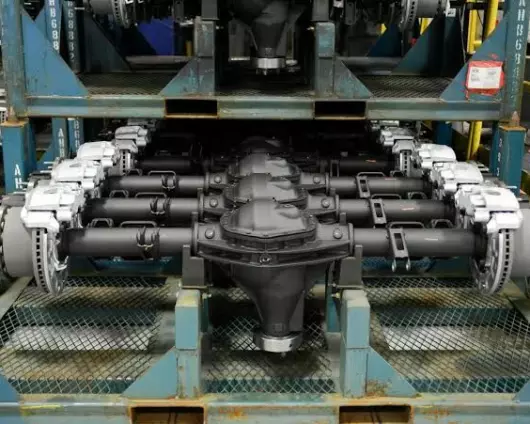
American Axle & Manufacturing gets tax break for $133m investment in Michigan site
-
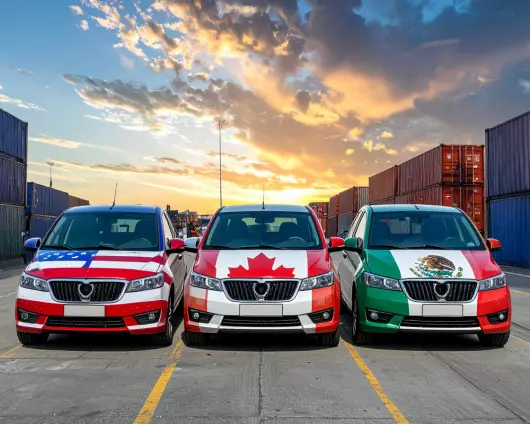
Tariffs and tensions: Trends in North American automotive logistics
-

Watch: VW's Anu Goel on strategies for dealing with uncertainty and the impact of tariffs on parts and service
-
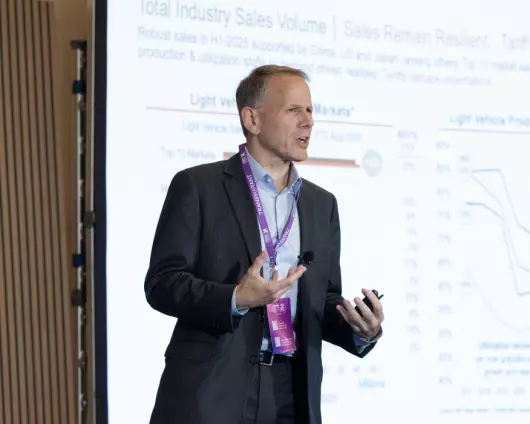
Carmakers spread the cost of tariffs but prices set to rise say analysts
-
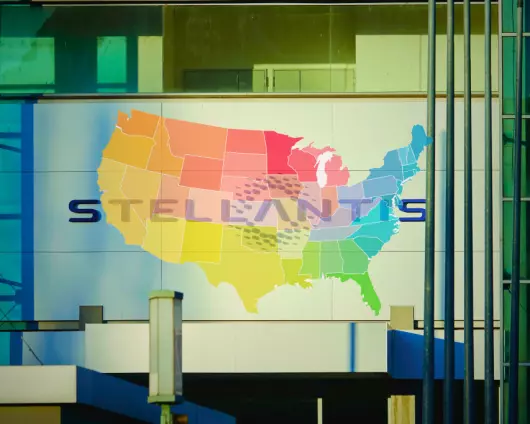
Stellantis invests $10bn in US manufacturing, reports say, while tariff negotiations continue
-
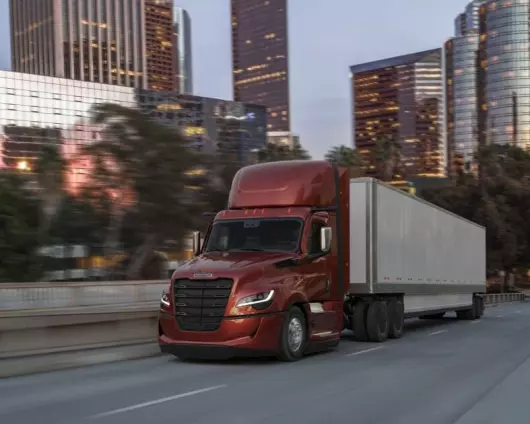
US truck tariff to come into effect on November 1, Trump confirms
-
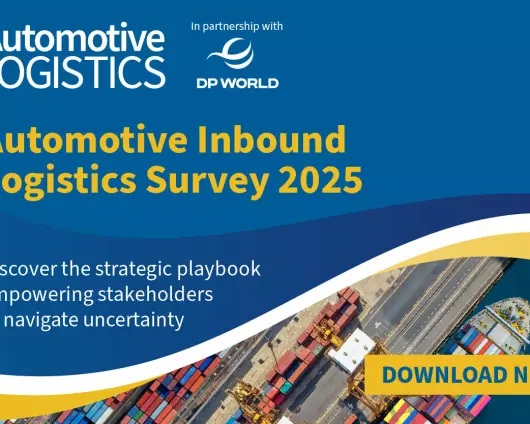
Automotive Inbound Logistics Survey 2025: Download now
-
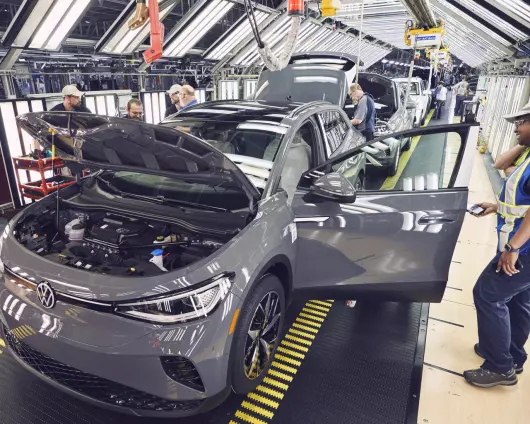
VW Group offers US localisation in tariff negotiations
-
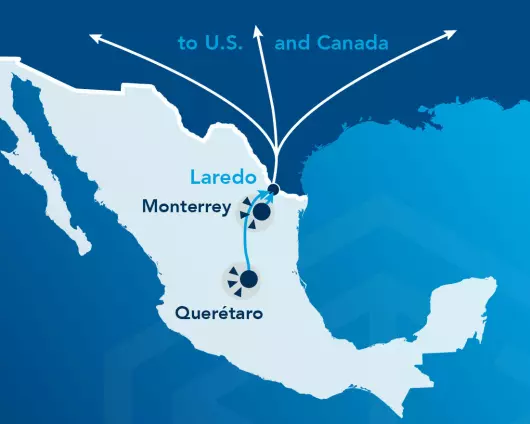
Cross-border automotive freight consolidation to mitigate US tariffs
-

Mexico raises tariffs on Chinese vehicles to 50%
-
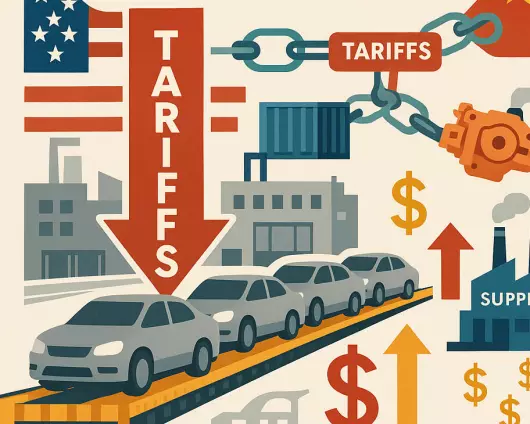
Tariff analysis deep dive: The most important changes for the auto industry
-
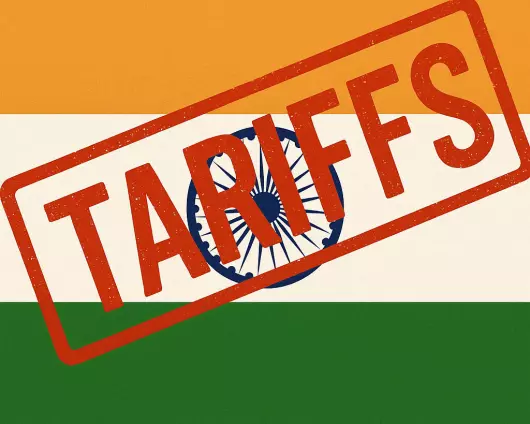
US implements 50% tariffs on India
-
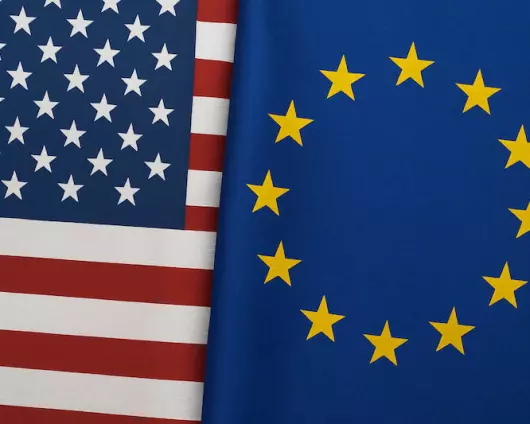
US and EU trade deal details: How auto industry will be affected
-

US extends 50% steel and aluminium tariffs, driving auto supply chain risk
-
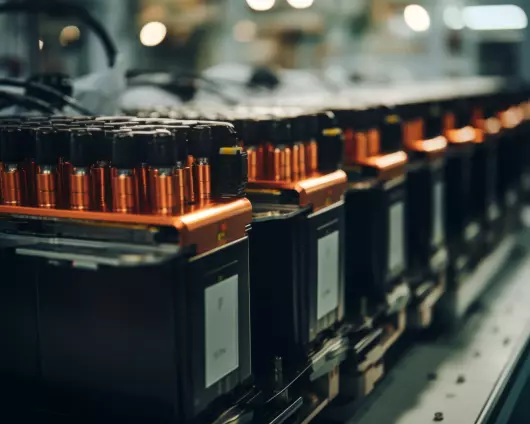
GM to import EV batteries from CATL despite tariffs
-

JLR profits halve due to US tariffs
-
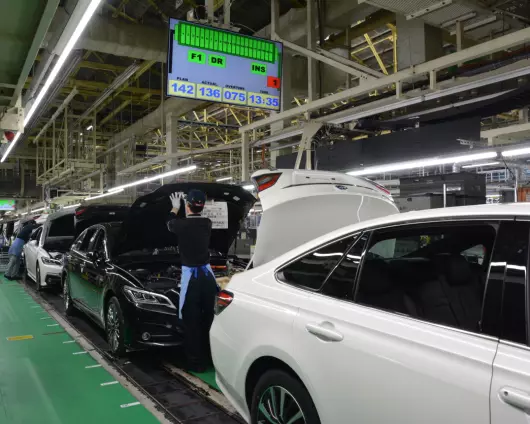
Toyota plans manufacturing plant in Japan, despite US tariff impact
-
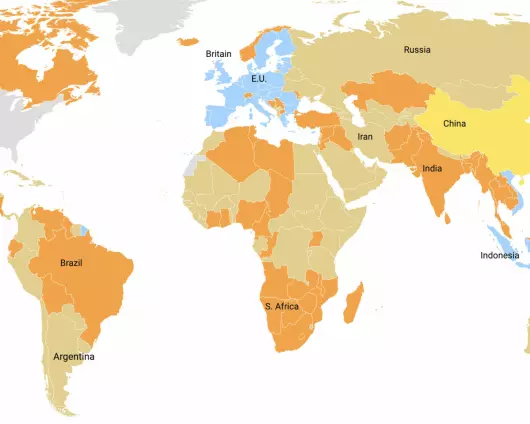
Interactive map: New US automotive tariffs & global trade rates (China, EU, Mexico)
-
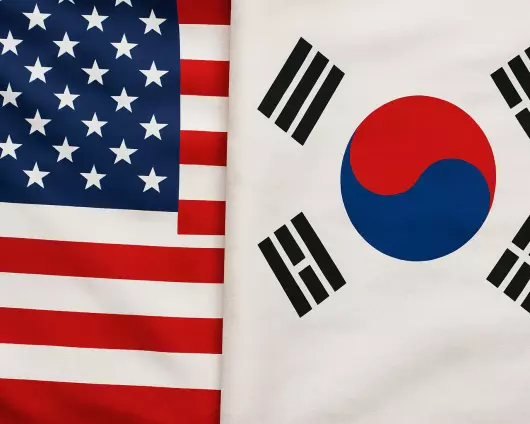
South Korea tariff deal with US: What it means for automotive
-
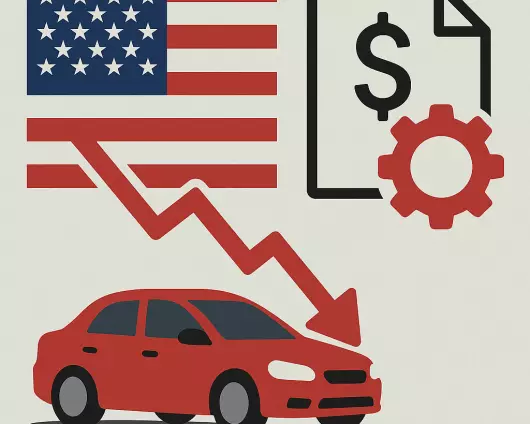
US announces new tariff rates, delays implementation again
-
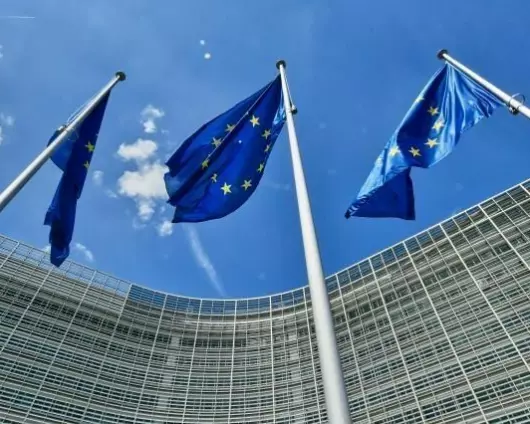
US and EU reach tariff deal, industry reacts
-
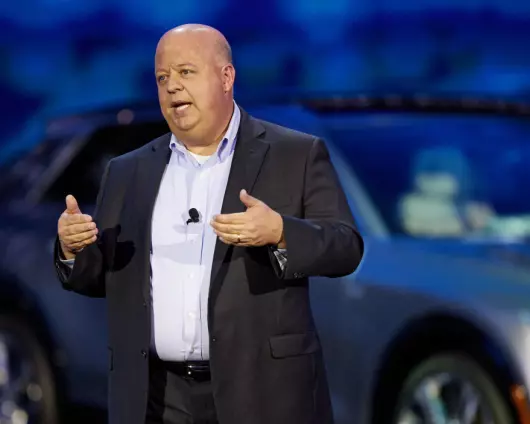
Trump tariffs cost GM over a billion dollars in Q2
-
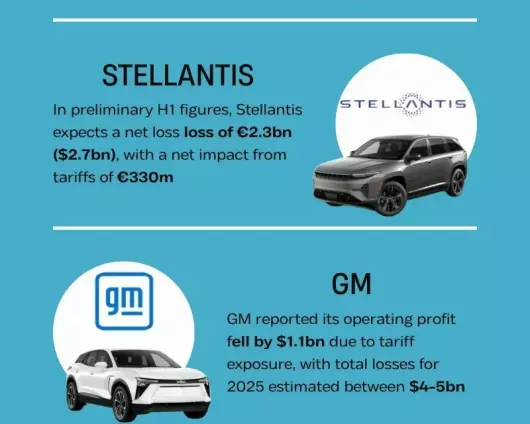
OEMs face financial losses as tariffs bite
-
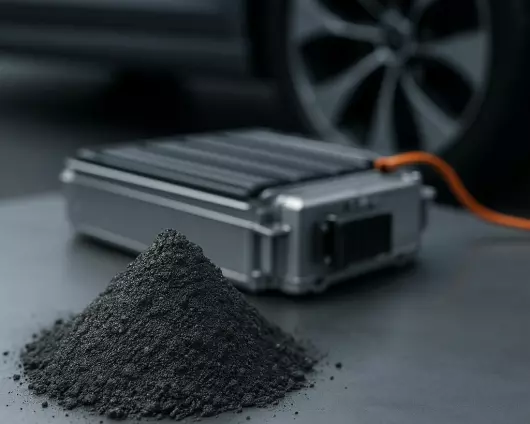
US reaches trade deal with Japan, puts 93% tariff on Chinese graphite
-
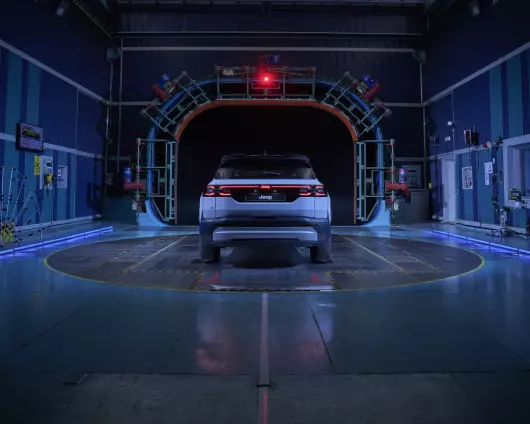
Stellantis expects loss of €2.3bn due to tariffs and restructuring
-
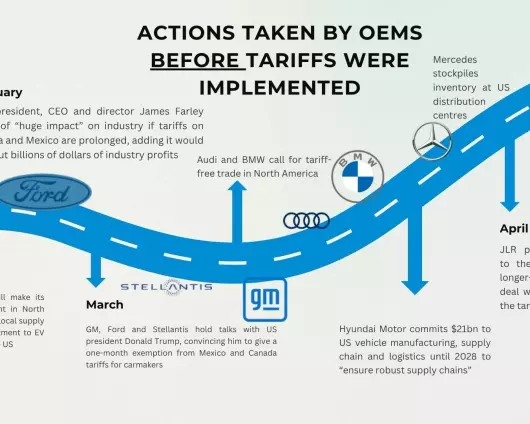
Actions taken by OEMs to curb effects of tariffs
-
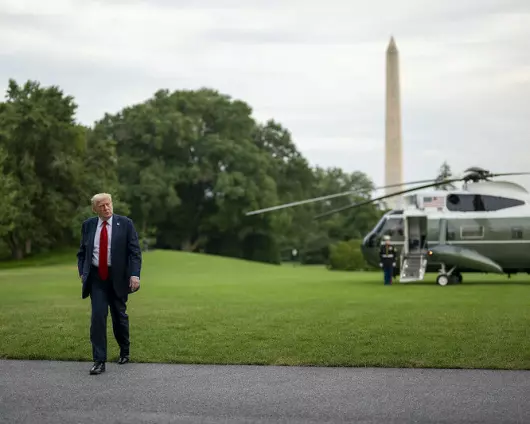
New tariff rates set for EU, Canada and Mexico
-
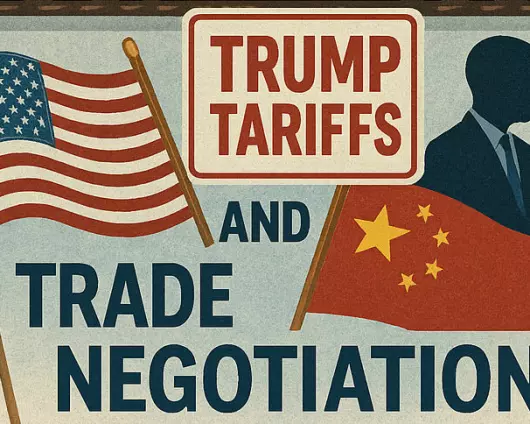
Trump tariff deadline: When rates will be set and implemented
-
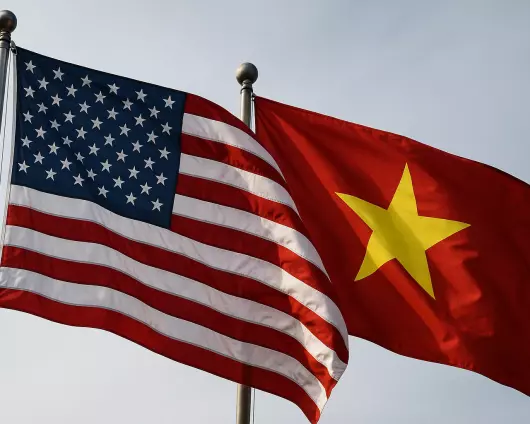
US-Vietnam trade deal: Impact on automotive sector
-
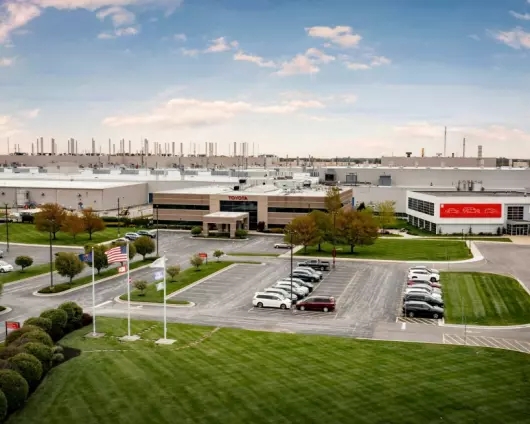
US threatens tariffs on Japan, OEMs face billions in losses
-
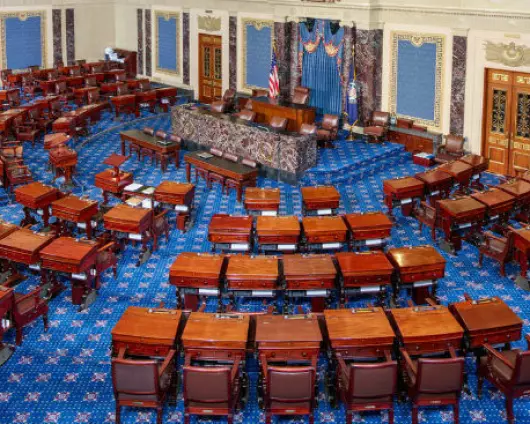
US Senate passes ‘Big Beautiful Bill’, ends EV tax credits
-
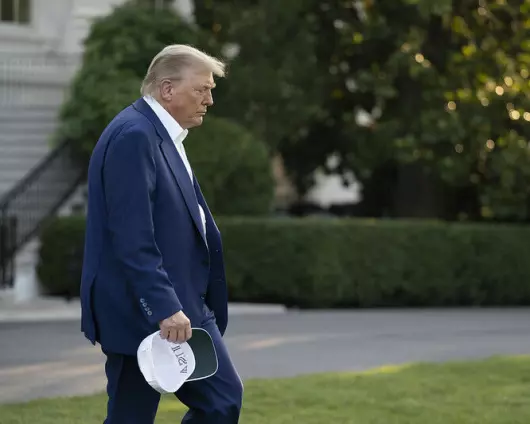
Latest tariff and trade updates affecting automotive industry
-
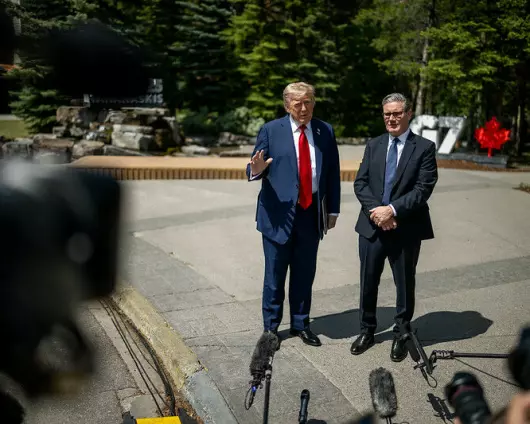
UK-US trade deal on vehicles partially implemented
-
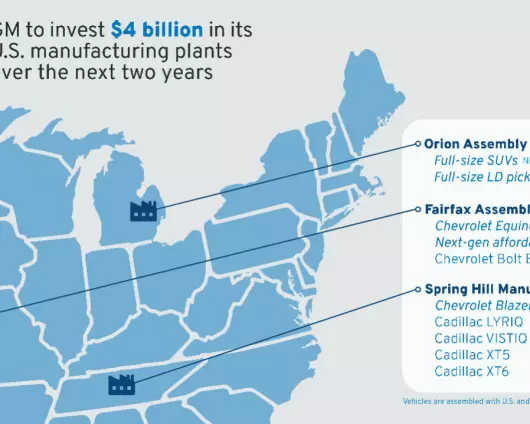
GM commits $4bn to US, moves assembly from Mexico and Canada
-

Can supply chains adapt faster than the automotive market changes?
-

Accuride’s Skotti Fietsam on increased collaboration between logistics and IT teams
-
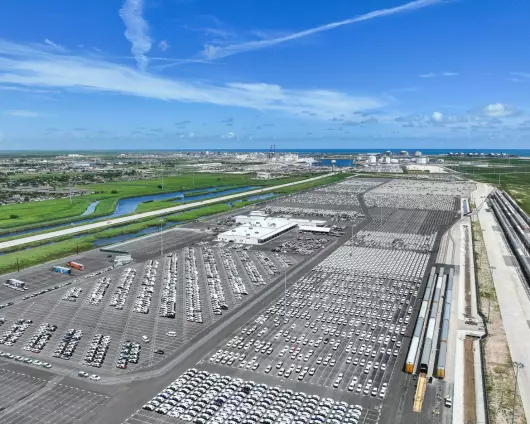
North America’s vehicle handling ports are investing in strength to manage volatility
-
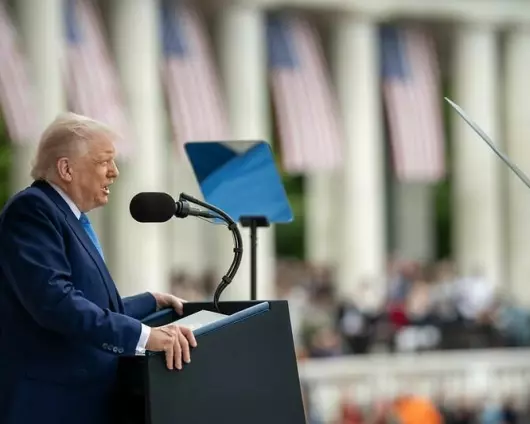
Trump tariffs back on following appeal of US Trade Court's block
-
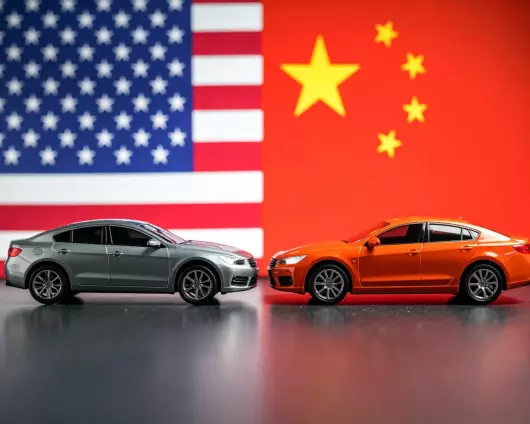
Despite minor setbacks, the Chinese automotive industry may come out as a winner in the tariff war
-

Potential US tariff cuts reshape global vehicle trade talks with EU, UK, China and more
-
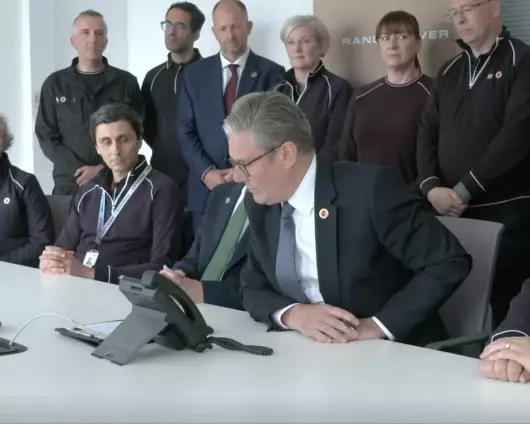
US-UK auto trade deal lowers vehicle import tariffs to 10% but caps UK exports at 100,000 vehicles
-

When disruption won’t quit, the 2025 Finished Vehicle Logistics conference shared how to stay balanced and agile
-

Artificially intelligent: Top 10 Red Sofa interviews on supply chain digitalisation
-
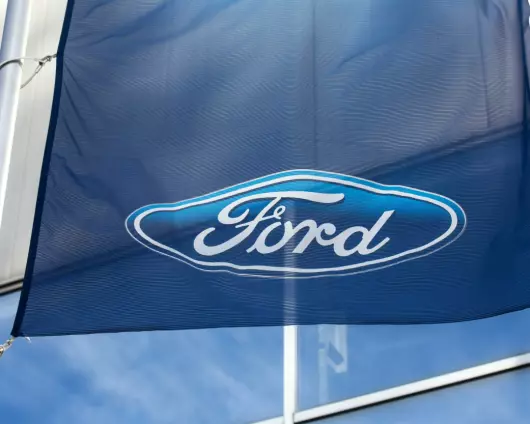
US automotive part tariffs come into effect as Ford forecasts $1.5bn hit and suspends financial guidance
-
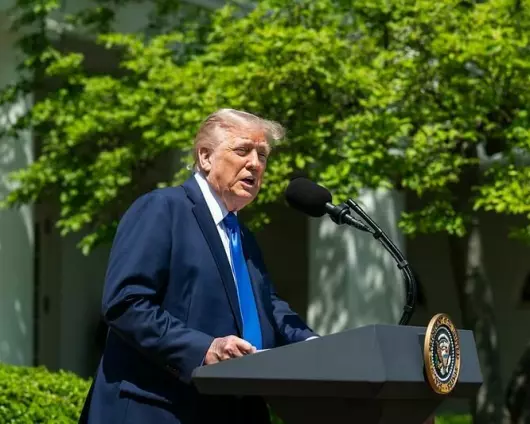
US provides auto industry tariff relief offsets and new limits on stacking duties
-
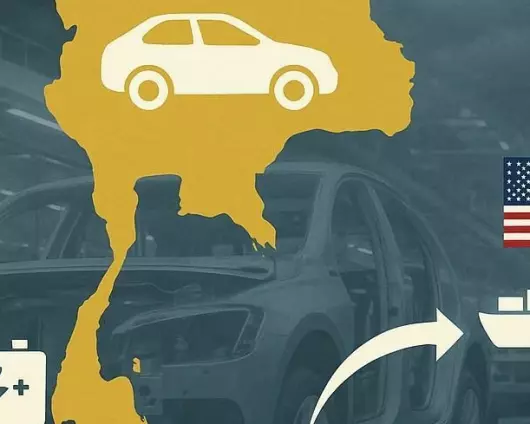
Thailand’s automotive supply chain challenges and opportunities for competitiveness in ASEAN
-
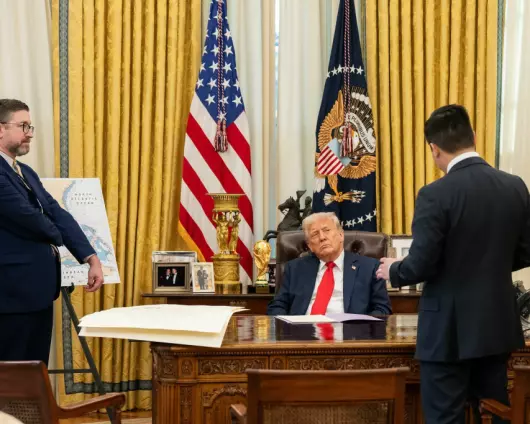
Opinion: Tariff shockwaves, investment freezes and cost pressure reshape global automotive logistics in 2025
-
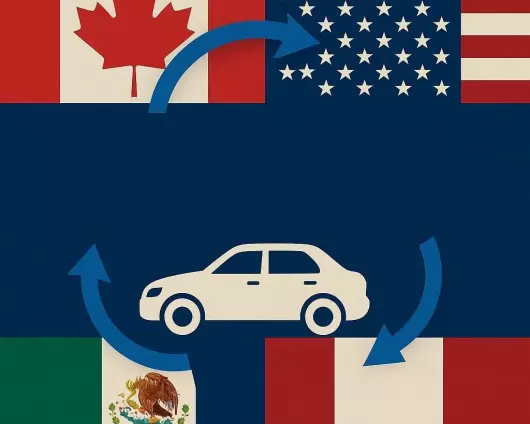
Trump’s 25% vehicle import tariffs could cost US carmakers $108bn and cut output by 17.7m vehicles
-

Red Sofa interview | Nissan’s Todd Myers on optimising FVL through data, digital tools and holistic planning
-

US automotive import tariffs hit prices and aggravate consumer uncertainty, says National Automobile Dealers Association
-
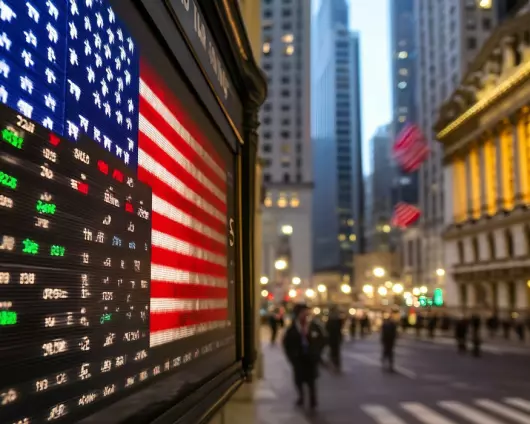
How Trump’s changing tariffs are disrupting automotive supply chains across China, Mexico, Canada and the EU
-
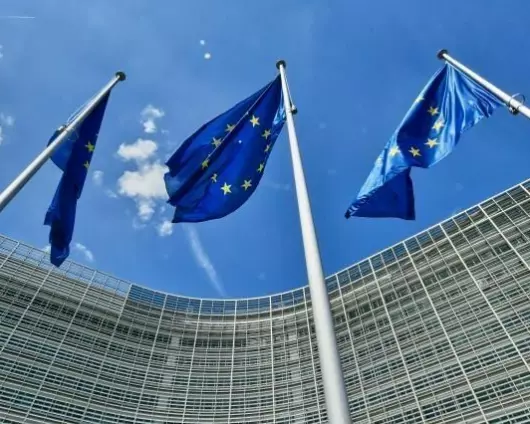
European Union imposes retaliatory tariffs on $20bn of US goods in response to Trump’s steel and aluminium duties
-
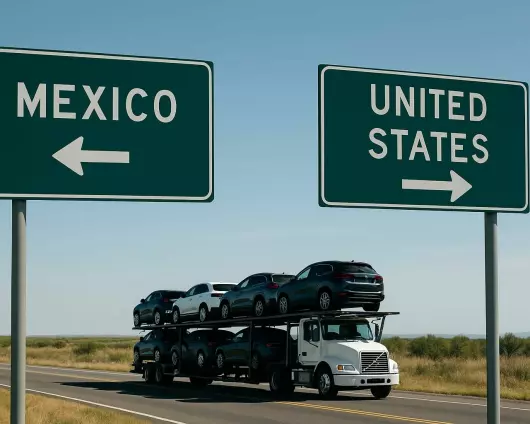
“Staying the course”: USMCOC’s Zapanta unpacks tariffs, automotive trade and North American integration
-
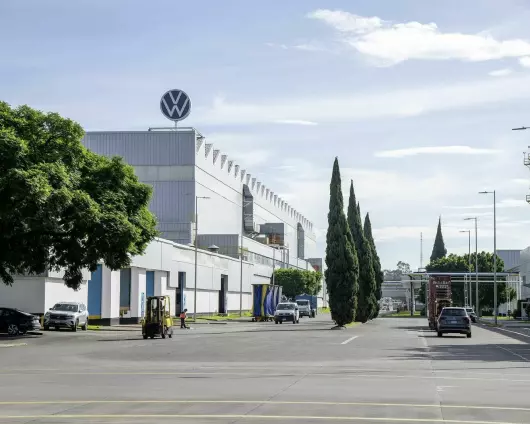
VW Group one of a number of carmakers revising exports of vehicles from Mexico to US
-
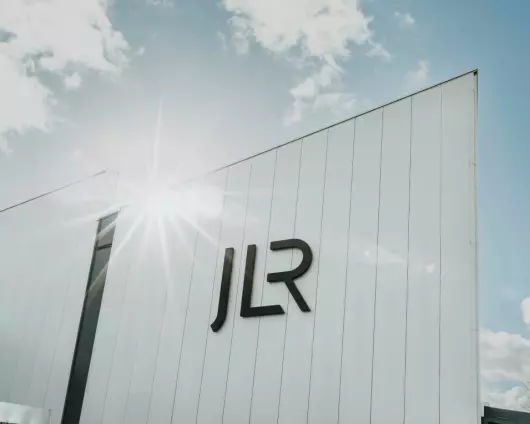
JLR restarts vehicle shipments to the US following a pause due Trump tariffs on car and parts imports
-

FVL North America 2025 opens with optimism, strategy and connection amid trade uncertainty
-
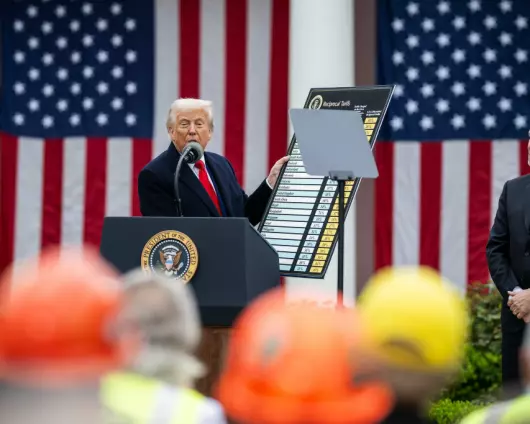
Trump’s “Liberation Day” automotive import tariffs disrupt global production, logistics and investment strategies
-

March 26 set the wheels in motion, here’s what’s coming before tariff D-Day on April 2
-
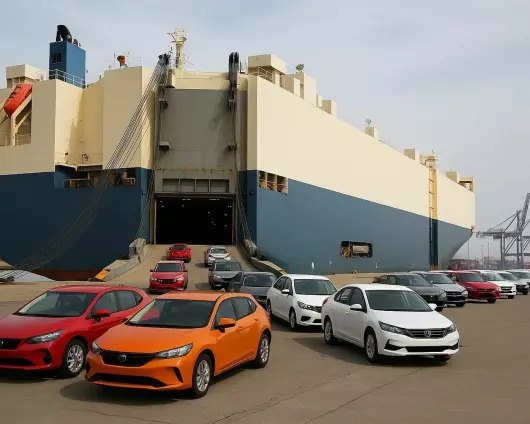
The race before the border closes, as auto logistics braces for a 25% tariff reckoning
-
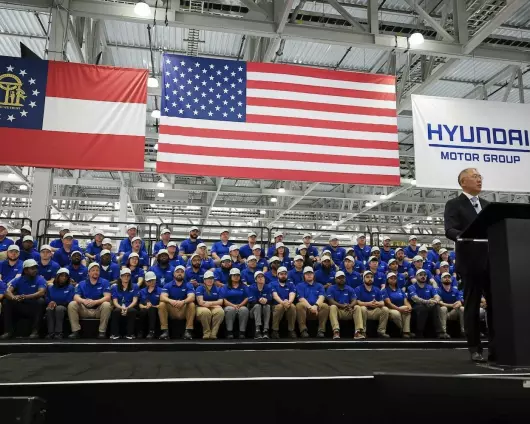
Hyundai Motor commits $21 billion to US vehicle manufacturing, supply chain and logistics
-
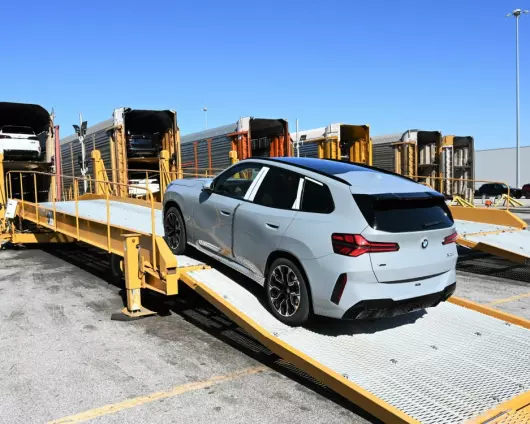
Audi and BMW call for tariff-free trade in North America as Trump tariffs take their toll
-

European Automotive Logistics Market Report 2025-2035
-

Automotive Logistics magazine – Spring 2025
-
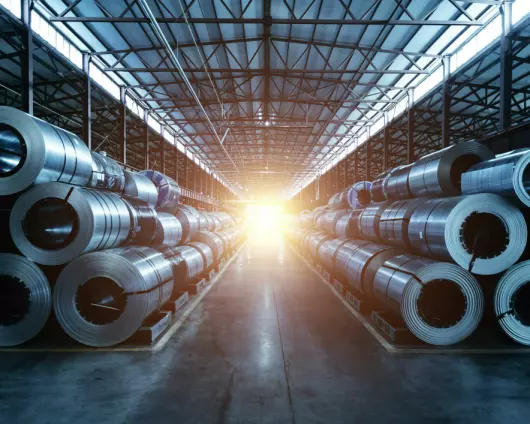
US to impose global tariffs of 25% on steel and aluminium imports; European Commission announces retaliatory levies
-
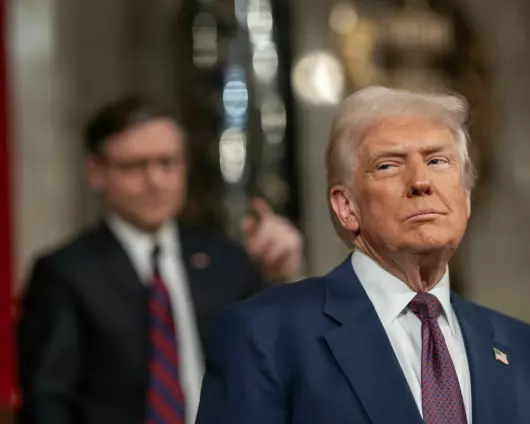
Exemptions will apply to carmakers in line with USMCA, following talks with GM, Ford, Stellantis
-
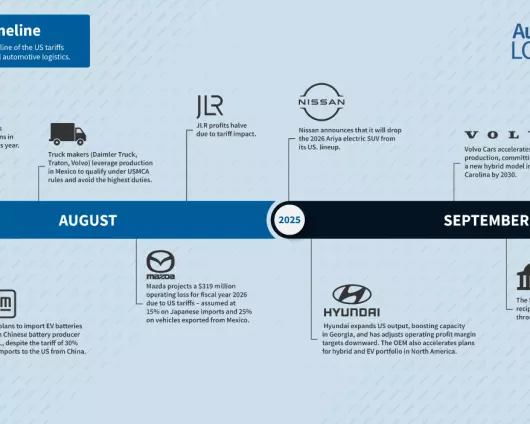
The US tariff timeline of trade tensions and tariff changes
-
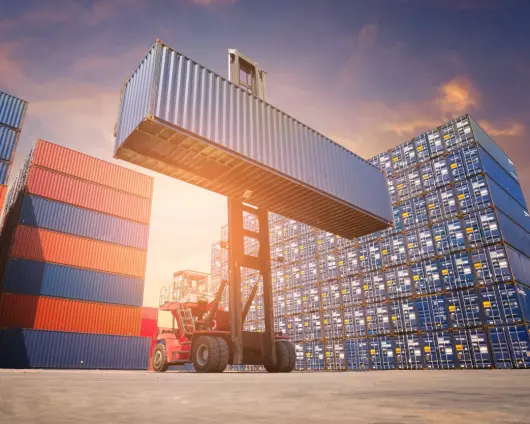
Donald Trump is imposing 25% tariffs on steel and aluminium from Canada and Mexico, and could include auto parts
-
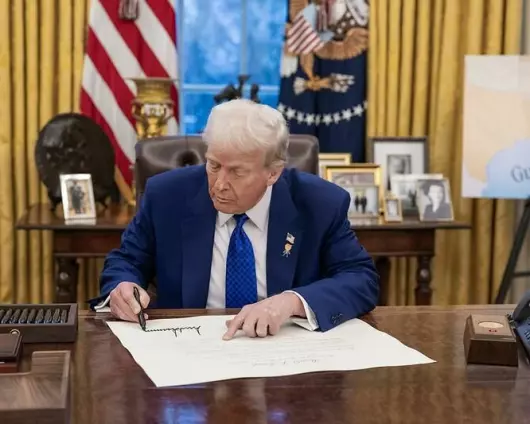
Trump’s reciprocal trade tariffs set to reshape global automotive supply chains and disrupt industry investment
-
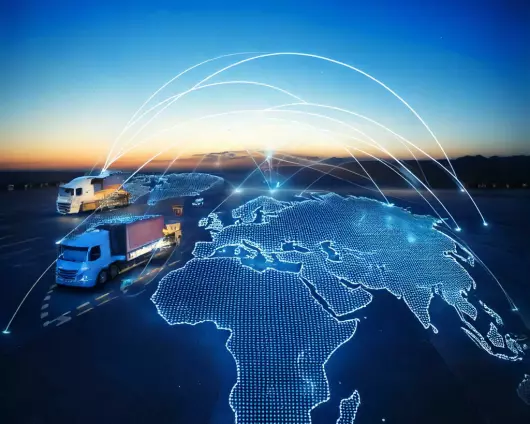
Automotive Logistics livestream on trends to watch in 2025: How trade shifts, tariffs and tech are reshaping networks
-

Ford’s president, CEO and director James Farley warns of serious financial impact on auto sector if Trump tariffs persist
-
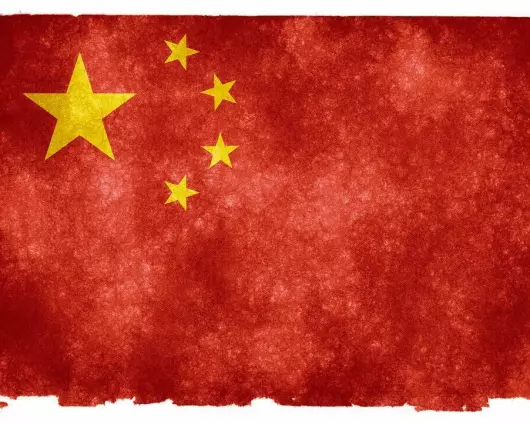
China retaliates against Trump’s auto tariffs with 10% duty on US vehicles and WTO complaint
-

Trump’s tariff pose on imports from Canada and Mexico tests resiliency of supply chain planners
-

Expert perspectives on nearshoring: Top 10 Red Sofa interviews on supply chain strategy
-

Global automotive industry shifts intensify challenges for logistics providers
-
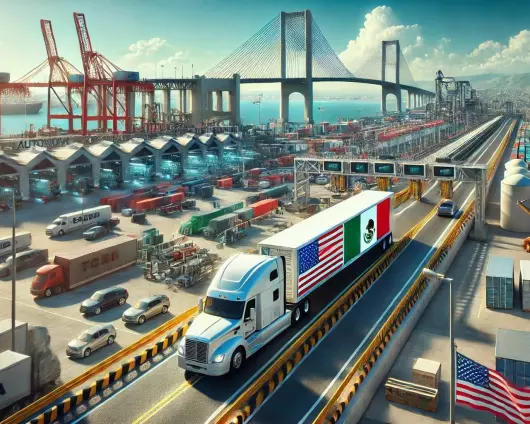
Trade disputes accelerate nearshoring trend with implications for logistics providers
-
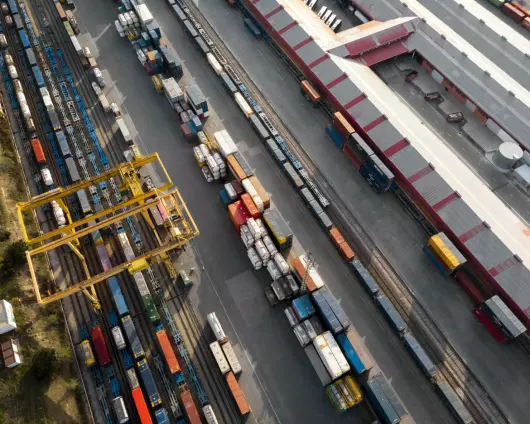
Automotive logistics and supply chains in 2025: Challenges, cost pressures & nearshoring
-
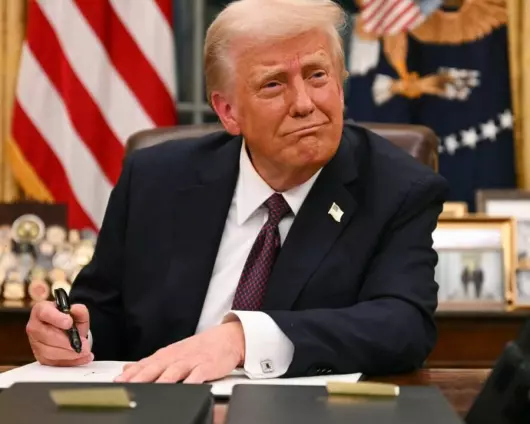
What day one under the Trump administration signals for the North American automotive supply chain
-
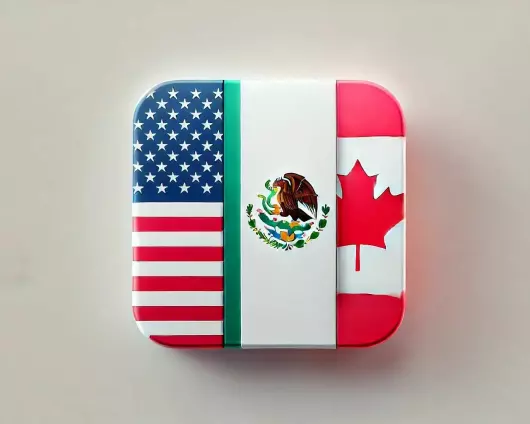
US-Mexico automotive trade faces new challenges amid shifting policies, labour costs and Chinese investment



